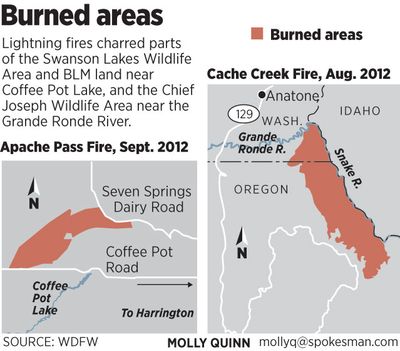Fires char BLM areas, Joseph Creek

Wild fires have blackened the prospects for hunting this season in specific areas of Washington and Idaho.
Weeks of rainless hot weather in August and September forced state and federal land managers to issue numerous restrictions.
Wild fires drove some early buck hunt hopefuls out of Wenatchee National Forest areas this month.
At about the same time, the Washington Department of Fish and Wildlife announced fire restrictions – no open fires, smoking or even target shooting – on all state wildlife areas until fire danger subsides.
BLM’s fire restrictions were supported by the region’s private landowners after the Apache Pass Fire spread over 24,531 acres south of Creston. The fire erupted during lightning storms on Sept. 9.
The fire charred 1,069 acres of the Swanson Lakes Wildlife Area, including some important habitat for sage and sharp-tailed grouse.
Considering that’s just 5 percent of the 21,000-acre (Swanson Lakes) Wildlife Area, “That’s not too bad,” said Juli Anderson, area manager for the WDFW.
“It burned fast and patchy leaving islands of unburned areas surrounded by burned areas that should green up nicely with new grass and fabulous wildflowers next year.”
Harder hit was the adjacent Twin Lakes area, where about 7,000 acres of U.S. Bureau of Land Management land was blackened.
Deer hunting in that area isn’t likely to be too good this year, Anderson said.
Farther south, the Cache Creek Fire along the Snake River, while mostly in Oregon, burned more than 5,300 acres of the 14,000-acre Chief Joseph Wildlife Area in Asotin County south of the Grande Ronde River.
The Joseph Creek area took the brunt of the flames and will be fruitless for most hunting this season, said Bob Dice, area manager.
About four miles of the Green Gulch Road, which is usually open for motorized hunter use Oct. 1-Nov. 30, will remain closed this year.
“I’m leaving the gate locked because the soils up there are very fragile and erodible after the burn,” he said. “Hunters can still go up there, but they won’t be able to drive.”